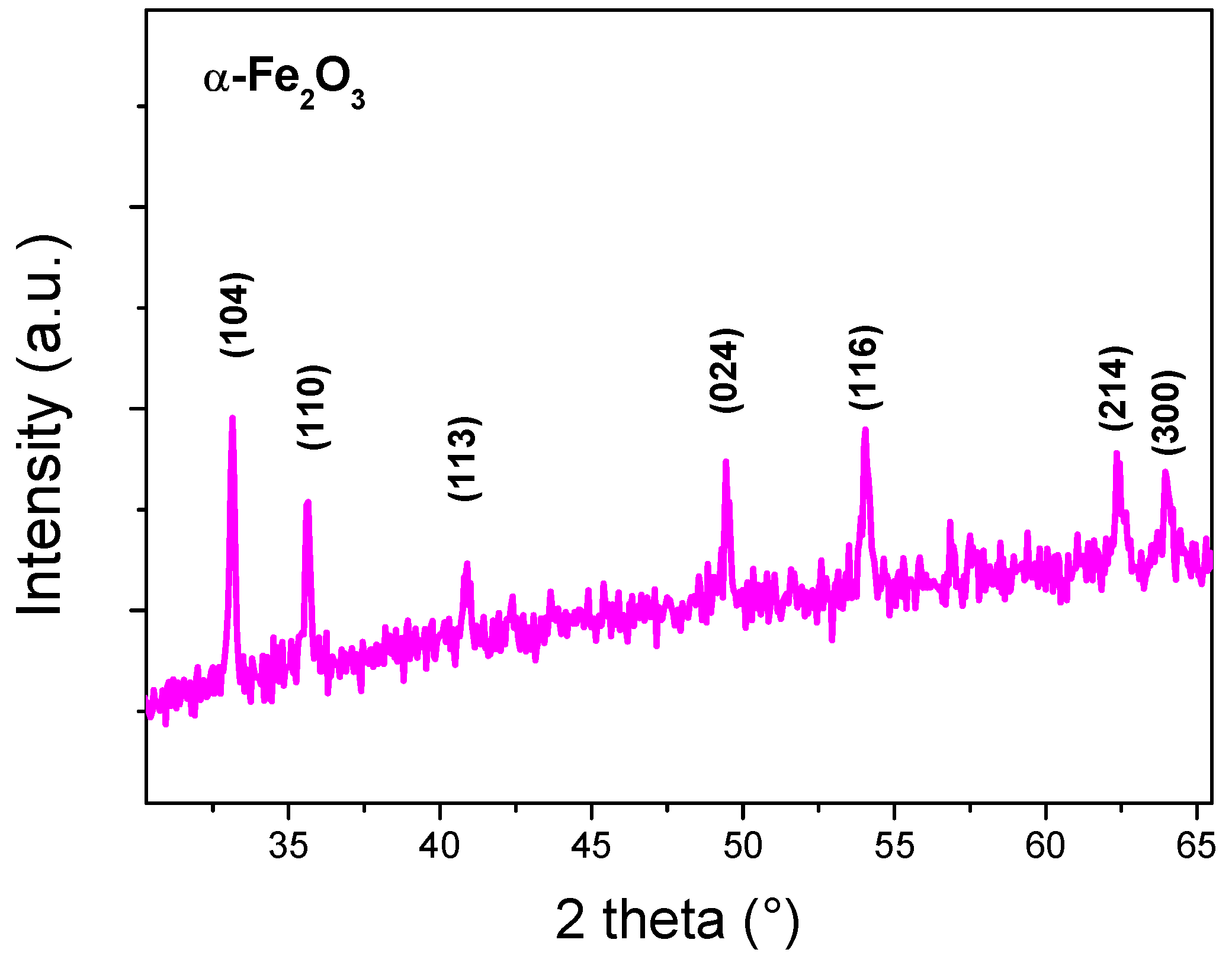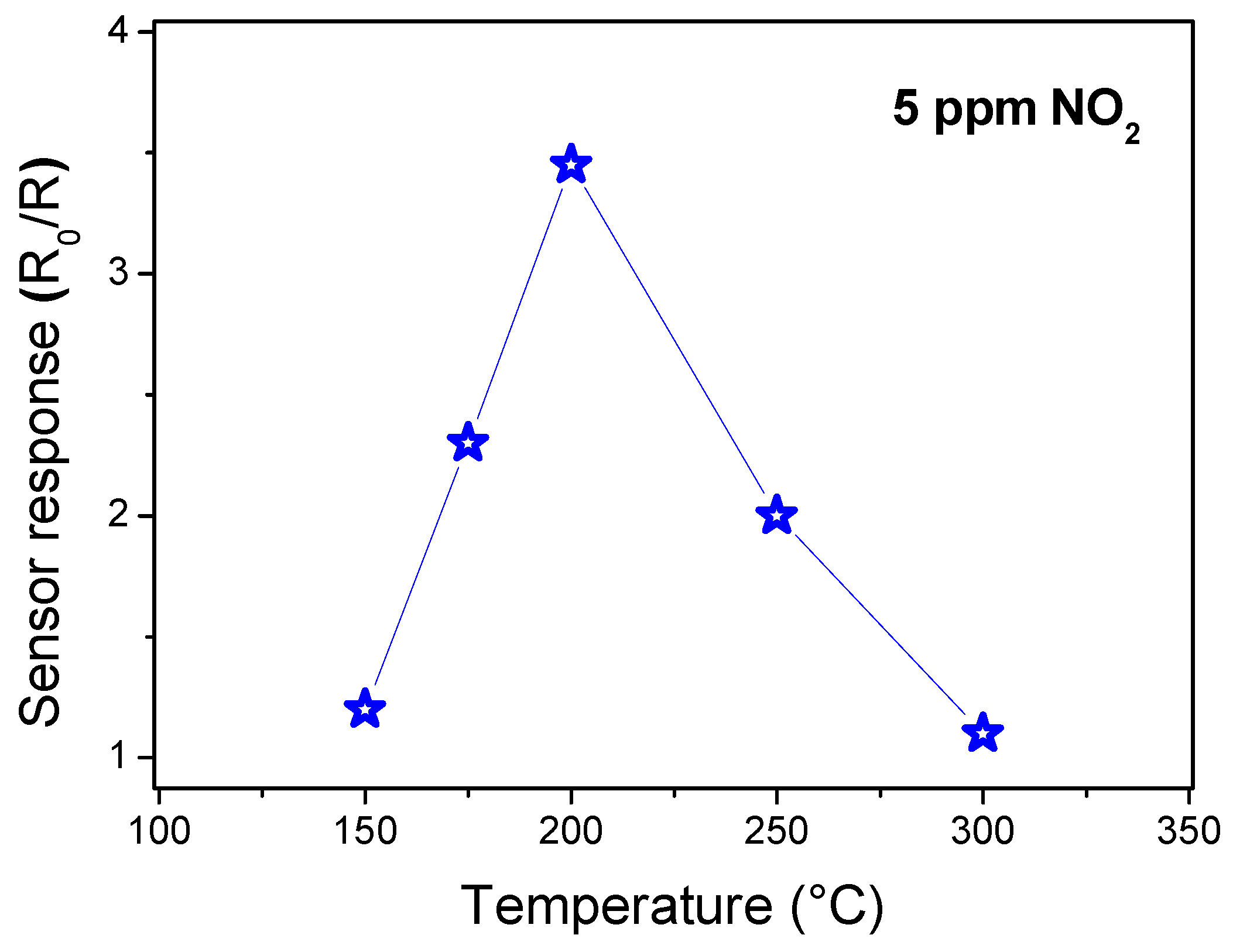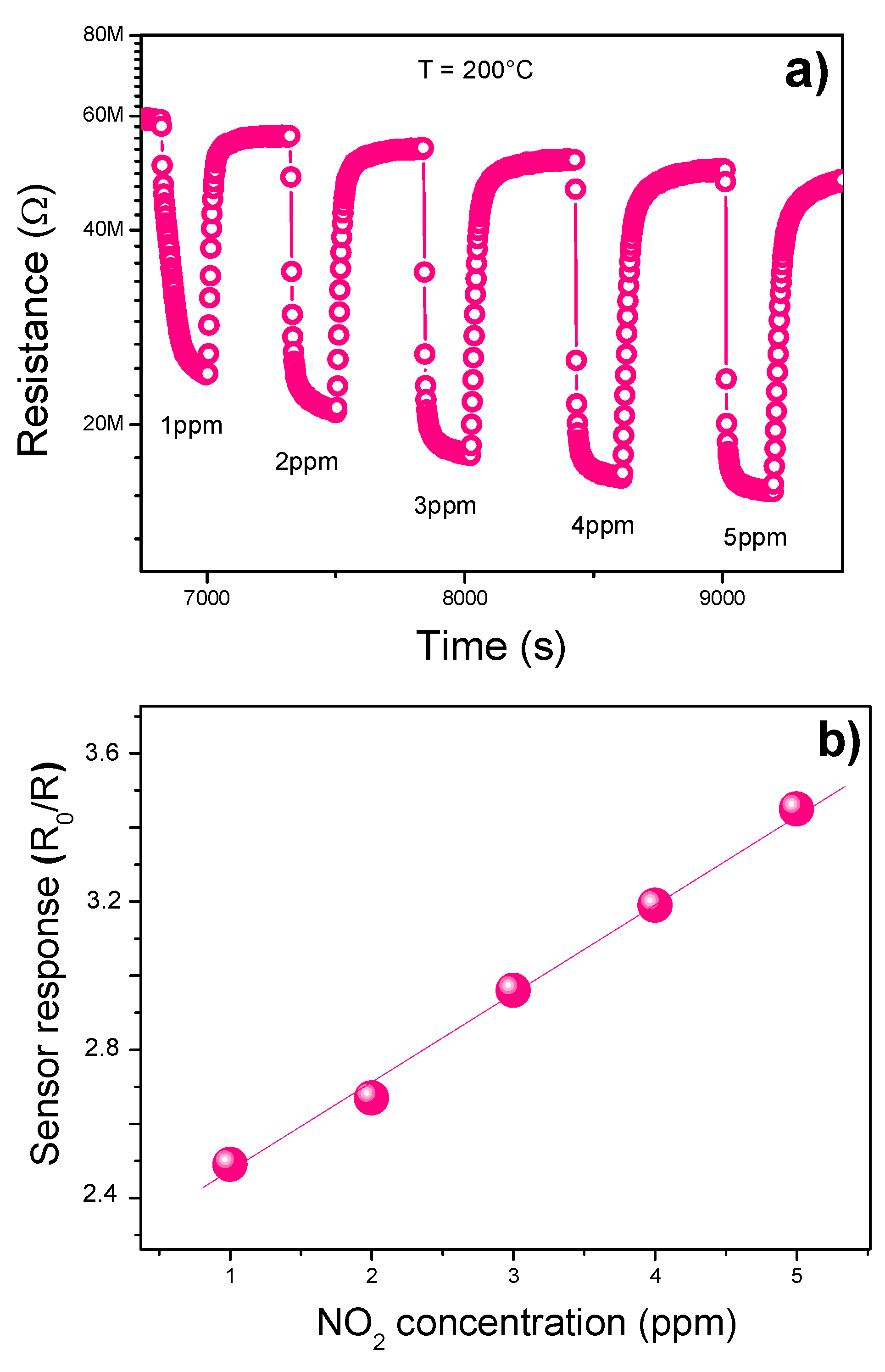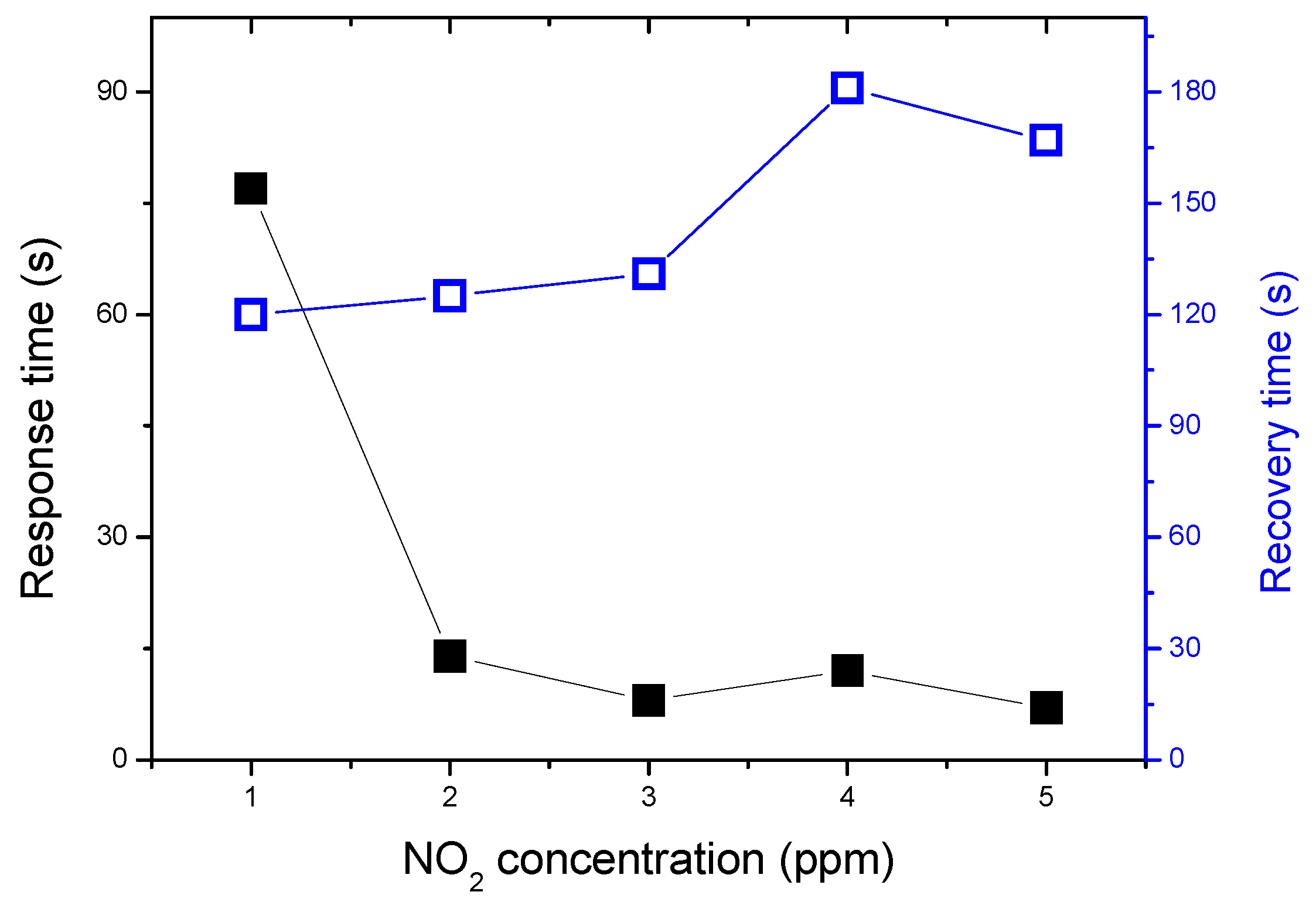NO2 Selective Sensor Based on α-Fe2O3 Nanoparticles Synthesized via Hydrothermal Technique
Abstract
:1. Introduction
2. Experimental Procedure
2.1. Preparation of α-Fe2O3 Nanoparticles
2.2. Characterization
2.3. Preparation of Sensor
3. Results and Discussion
3.1. Microstructure and Morphology
3.2. Sensing Properties
4. Conclusions
Author Contributions
Funding
Acknowledgments
Conflicts of Interest
References
- Brunet, J.; Dubois, M.; Pauly, A.; Spinelle, L.; Ndiaye, A.; Guérin, K.; Varenne, C.; Lauron, B. An innovative gas sensor system designed from a sensitive organic semiconductor downstream a nanocarbonaceous chemical filter for the selective detection of NO2 in an environmental context: Part I: Development of a nanocarbon filter for the removal of ozone. Sens. Actuators B 2012, 173, 659–667. [Google Scholar]
- Patnaik, P. A Comprehensive Guide to the Hazardous Properties of Chemical Substances; John Wiley & Sons, Inc.: Hoboken, NJ, USA, 2007; p. 1060. [Google Scholar]
- Bochenkov, V.E.; Sergeev, G.B. Preparation and chemiresistive properties of nanostructured materials. Adv. Colloid Interface Sci. 2005, 116, 245–254. [Google Scholar] [CrossRef] [PubMed]
- Qureshi, A.; Mergen, A.; Altindal, A. Preparation and characterization of Li and Ti codoped NiO nanocomposites for gas sensors applications. Sens. Actuators B 2009, 135, 537–540. [Google Scholar] [CrossRef]
- Soleimanpour, A.M.; Hou, Y.H.; Jayatissa, A. Surface and gas sensing properties of nanocrystalline nickel oxide thin films. Appl. Surf. Sci. 2011, 257, 5398–5402. [Google Scholar] [CrossRef]
- Zhu, L.; Zeng, W. Room-temperature gas sensing of ZnO-based gas sensor: A review. Sens. Actuators A 2017, 267, 242–261. [Google Scholar] [CrossRef]
- Liu, X.; Ma, T.; Xu, Y.; Sun, L.; Zheng, L.; Schmidt, O.G.; Zhang, J. Rolled-up SnO2 nanomembranes: A new platform for efficient gas sensors. Sens. Actuators B 2018, 264, 92–99. [Google Scholar] [CrossRef]
- Velusamy, P.; Babu, R.R.; Ramamurthi, K.; Elangovan, E.; Viegas, J.; Sridharan, M. Spray deposited ruthenium incorporated CdO thin films for opto-electronic and gas sensing applications. J. Phys. Chem. Solids 2018, 112, 127–136. [Google Scholar] [CrossRef]
- Swati, R.; Gawali, V.L.; Patil, V.G.; Deonikar, S.S.; Patil, D.R.; Patil, P.S.; Patil, J.P. Ce doped NiO nanoparticles as selective NO2 gas sensor. J. Phys. Chem. Solids 2018, 114, 28–35. [Google Scholar]
- Liang, S.; Li, J.; Wang, F.; Qina, J.; Lai, X.; Jiang, X. Highly sensitive acetone gas sensor based on ultrafine α-Fe2O3 nanoparticles. Sens. Actuators B 2017, 238, 923–927. [Google Scholar] [CrossRef]
- Neri, G. First Fifty Years of Chemoresistive Gas Sensors. Chemosensors 2015, 3, 1–20. [Google Scholar] [CrossRef] [Green Version]
- Hjiri, M.; el Mir, L.; Leonardi, S.G.; Pistone, A.; Mavilia, L.; Neri, G. Al-doped ZnO for highly sensitive CO gas sensors. Sens. Actuators B 2014, 196, 413–420. [Google Scholar] [CrossRef]
- Balouria, V.; Kumar, A.; Samanta, S.; Singha, A.; Debnath, A.K.; Mahajan, A.; Bedi, R.K.; Aswal, D.K.; Gupta, S.K. Temperature Dependent H2S and Cl2 Sensing Selectivity of Cr2O3 Thin Films. Sens. Actuators B 2013, 181, 471–478. [Google Scholar] [CrossRef]
- Liu, Z.; Lv, B.; Wu, D.; Sun, Y.; Xu, Y. Preparation and Properties of Octadecahedral α-Fe2O3 Nanoparticles Enclosed by {104} and {112} Facets. Eur. J. Inorg. Chem. 2012, 2012, 4076–4081. [Google Scholar] [CrossRef]
- Cai, J.; Chen, S.; Ji, M.; Hu, J.; Ma, Y.; Qi, L. Organic additive-free synthesis of mesocrystalline hematite nanoplates via two-dimensional oriented attachment. Cryst. Eng. Comm. 2014, 16, 1553–1559. [Google Scholar] [CrossRef]
- Tao, B.; Zhang, Q.; Liu, Z.Z.; Geng, B.Y. Cooperative effect of pH value and anions on single-crystalline hexagonal and circular α-Fe2O3 nanorings. Mater. Chem. Phys. 2012, 136, 604–612. [Google Scholar] [CrossRef]
- Reda, S.M. Synthesis of ZnO and Fe2O3 nanoparticles by sol-gel method and their application in dye-sensitized solar cells. Mater. Sci. Semicond. Process 2010, 13, 417–425. [Google Scholar] [CrossRef]
- Darezereshki, E.; Bakhtiari, F.; Alizadeh, M.; Vakylabad, A.B.; Ranjbar, M. Innovative impregnation process for production of γ-Fe2O3-activated carbon nanocomposite. Mater. Sci. Semicond. Process 2012, 15, 91–97. [Google Scholar] [CrossRef]
- He, K.; Xu, C.Y.; Zhen, L.; Shao, W.Z. Fractal growth of single-crystal α-Fe2O3: From dendritic micro-pines to hexagonal micro-snowflakes. Mater. Lett. 2008, 62, 739–742. [Google Scholar] [CrossRef]
- Zhang, Z.H.; Hossain, M.F.; Takahashi, T. Fabrication of shape-controlled α-Fe2O3 nanostructures by sonoelectrochemical anodization for visible light photocatalytic application. Mater. Lett. 2010, 64, 435–438. [Google Scholar] [CrossRef]
- Thangadurai, V.; Kopp, P. Chemical synthesis of Ca-doped CeO2—Intermediate temperature oxide ion electrolytes. J. Power Sources 2007, 168, 178–183. [Google Scholar] [CrossRef]
- Navale, S.T.; Bandgar, D.K.; Nalage, S.R.; Khuspe, G.D.; Chougule, M.A.; Kolekar, Y.D.; Sen, S.; Patil, V.B. Synthesis of Fe2O3 nanoparticles for nitrogen dioxide gas sensing applications. Ceram. Int. 2013, 39, 6453–6460. [Google Scholar] [CrossRef]
- Pandeeswari, R.; Karn, R.K.; Jeyaprakash, B.G. Ethanol sensing behaviour of sol-gel dip-coated TiO2 thin films. Sens. Actuators B 2014, 194, 470–477. [Google Scholar] [CrossRef]
- Wang, Y.; Cao, J.; Kong, F.; Xia, H.; Zhang, J.; Zhu, B.; Wang, S.; Wu, S. Low-temperature H2S sensors based on Ag-doped α-Fe2O3 nanoparticles. Sens. Actuators B 2008, 131, 183–189. [Google Scholar] [CrossRef]
- Biswal, R.C. Pure and Pt-loaded gamma iron oxide as sensor for detection of sub ppm level of acetone. Sens. Actuators B Chem. 2011, 157, 183–188. [Google Scholar] [CrossRef]
- Liao, L.; Zheng, Z.; Yan, B.; Zhang, J.X.; Gong, H.; Li, J.C.; Liu, C.; Shen, Z.X.; Yu, T. Morphology controllable synthesis of α-Fe2O3 1D nanostructurs: Growth mechanism and nanodevice based on single nanowire. J. Phys. Chem. C 2008, 112, 10784–10788. [Google Scholar] [CrossRef]
- Wang, L.; Fei, T.; Lou, Z.; Zhang, T. Three-Dimensional Hierarchical Flowerlike α-Fe2O3 Nanostructures: Synthesis and Ethanol-Sensing Properties. ACS Appl. Mater. Interfaces 2011, 3, 4689–4694. [Google Scholar] [CrossRef] [PubMed]
- Cuong, N.D.; Khieu, D.Q.; Hoa, T.T.; Quang, D.T.; Viet, P.H.; Lam, T.D.; Hoa, N.D.; Hieu, N.V. Facile Synthesis of α-Fe2O3 Nanoparticles for High-Performance CO Gas Sensor. Mater. Res. Bull. 2015, 68, 302–307. [Google Scholar] [CrossRef]
- Mathevulaa, L.E.; Notoa, L.L.; Mothudia, B.M.; Chithambob, M.; Dhlamini, M.S. Structural and optical properties of sol-gel derived α-Fe2O3 nanoparticles. J. Lumin. 2017, 192, 879–887. [Google Scholar] [CrossRef]
- Cullity, B.D. Elements of X-ray Diffraction; Addison-Wesley: Boston, MA, USA, 1978; p. 102. [Google Scholar]
- Lehraki, N.; Aida, M.S.; Abed, S.; Attaf, N.; Attaf, A.; Poulain, M. ZnO thin films deposition by spray pyrolysis: Influence of precursor solution properties. Curr. Appl. Phys. 2012, 12, 1283–1287. [Google Scholar] [CrossRef]
- Jin, W.X.; Ma, S.Y.; Tie, Z.Z.; Jiang, X.H.; Li, W.Q.; Luo, J.; Xu, X.L.; Wang, T.T. Hydrothermal synthesis of mono disperse porous cube, cake and spheroid-like a-Fe2O3 particles and their high gassensing properties. Sens. Actuators B 2015, 220, 243–254. [Google Scholar] [CrossRef]
- Zeng, Q.Z.; Ma, S.Y.; Jin, W.X.; Yang, H.M.; Chen, H.; Ge, Q.; Ma, L. Hydrothermal synthesis of monodisperse α-Fe2O3 hollow microspheroids and their high gas-sensing properties. J. Alloy. Compd. 2017, 705, 427–437. [Google Scholar] [CrossRef]
- Hung, C.M.; Hoa, N.D.; Duy, N.V.; Toan, N.V.; Le, D.T.T.; Hieu, N.V. Synthesis and gas-sensing characteristics of α-Fe2O3 hollow balls. J. Sci. Adv. Mater. Devices 2016, 1, 45–50. [Google Scholar] [CrossRef]
- Chougule, M.A.; Sen, S.; Patil, V.B. Fabrication of nanostructured ZnO thin film sensor for NO2 monitoring. Ceram. Int. 2012, 38, 2685–2692. [Google Scholar] [CrossRef]
- Mirzaei, A.; Janghorban, K.; Hashemi, B.; Bonyani, M.; Leonardi, S.G.; Neri, G. Highly stable and selective ethanol sensor based on α-Fe2O3 nanoparticles prepared by Pechini sol-gel method. Ceram. Int. 2016, 42, 6136–6144. [Google Scholar] [CrossRef]
- Navale, S.T.; Khuspe, G.D.; Chougule, M.A.; Patil, V.B. Room temperature NO2 gas sensor based on PPy/α-Fe2O3 hybrid nanocomposites. Ceram. Int. 2014, 40, 8013–8020. [Google Scholar] [CrossRef]
- Zhang, B.; Liu, G.; Cheng, M.; Gao, Y.; Zhao, L.; Li, S.; Liu, F.; Yan, X.; Zhang, T.; Sun, P.; et al. The preparation of reduced graphene oxide-encapsulated α-Fe2O3 hybrid and its outstanding NO2 gas sensing properties at room temperature. Sens. Actuators B 2018, 261, 252–263. [Google Scholar] [CrossRef]
- Saritas, S.; Kundakci, M.; Coban, O.; Tuzemen, S.; Yildirim, M. Ni: Fe2O3, Mg: Fe2O3 and Fe2O3 thin films gas sensor application. Phys. B Condens. Matter 2018, 541, 14–18. [Google Scholar] [CrossRef]
- Yamazoe, N.; Sakai, G.; Shimanoe, K. Oxide semiconductor gas sensors. Catal. Surv. Asia 2003, 7, 63–75. [Google Scholar] [CrossRef]
- Dayan, N.J.; Sainkar, S.R.; Karekar, R.N.; Aiyer, R.C. Formulation and characterization of ZnO:Sb thick-film gas sensors. Thin Solid Films 1998, 325, 254–258. [Google Scholar] [CrossRef]
- Gurlo, A.; Sahm, M.; Oprea, A.; Barsan, N.; Weimar, U. A p- to n-transition on α-Fe2O3-basedthick film sensors studied by conductance and work function change measurements. Sens. Actuators B 2004, 102, 291–298. [Google Scholar] [CrossRef]








| Material | Target Gas | Operating Temperature (°) | Tested Gases | Preparation Technique | Response to NO2 (ΔR/R0)% | Ref. |
|---|---|---|---|---|---|---|
| α-Fe2O3 | NO2 | 200 | NO2, H2S, acetone methanol, NH3 | Sol-gel | 17.2 (200 ppm) | [22] |
| α-Fe2O3 | Ethanol | 225 | NO2, CO, acetone, CO2, NH3, H2, O2 | Sol-gel | 90 (100 ppm) | [36] |
| Polypyrrole/α-Fe2O3 | NO2 | 200 | NO2, NH3, ethanol, H2S, methanol, Cl2 | Sol-gel | 54 (100 ppm) | [37] |
| graphene/α-Fe2O3 | NO2 | 120 | NO2 | Hydrothermal | 8.2 (5 ppm) | [38] |
| α-Fe2O3 | NO2 | 200 | NO2, H2S, acetone methanol, NH3 | Spray pyrolysis | 17.2 (200 ppm) | [39] |
| α-Fe2O3 | NO2 | 200 | NO2, CO, CO2 | Hydrothermal | 59.9 (1 ppm) | This work |
© 2019 by the authors. Licensee MDPI, Basel, Switzerland. This article is an open access article distributed under the terms and conditions of the Creative Commons Attribution (CC BY) license (http://creativecommons.org/licenses/by/4.0/).
Share and Cite
Hjiri, M.; Aida, M.S.; Neri, G. NO2 Selective Sensor Based on α-Fe2O3 Nanoparticles Synthesized via Hydrothermal Technique. Sensors 2019, 19, 167. https://doi.org/10.3390/s19010167
Hjiri M, Aida MS, Neri G. NO2 Selective Sensor Based on α-Fe2O3 Nanoparticles Synthesized via Hydrothermal Technique. Sensors. 2019; 19(1):167. https://doi.org/10.3390/s19010167
Chicago/Turabian StyleHjiri, Mokhtar, Mohamed Salah Aida, and Giovanni Neri. 2019. "NO2 Selective Sensor Based on α-Fe2O3 Nanoparticles Synthesized via Hydrothermal Technique" Sensors 19, no. 1: 167. https://doi.org/10.3390/s19010167





